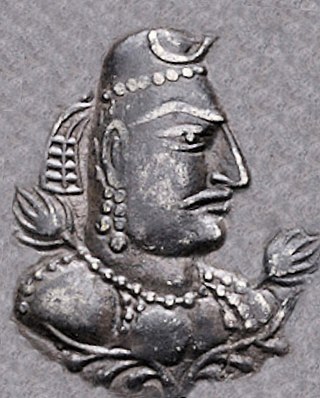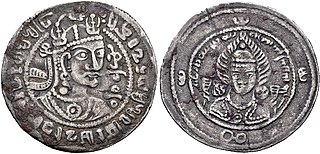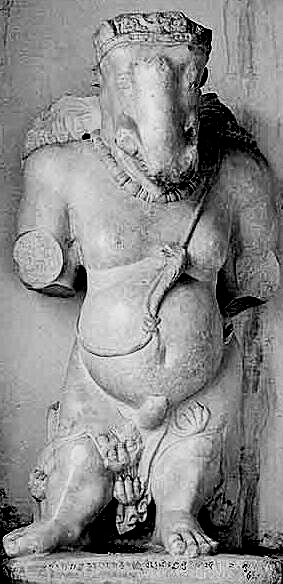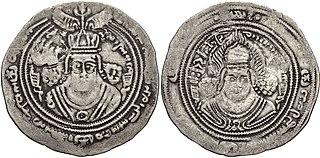
Zabulistan, was a historical region in southern Afghanistan roughly corresponding to the modern provinces of Zabul and Ghazni. Following the Ghaznavid rule (977–1186), "Zabul" became largely synonymous with the name of its capital and main city, Ghazni.
Hyecho, Sanskrit: Prajñāvikrama; pinyin: Hui Chao, was a Buddhist monk from Silla, one of the Three Kingdoms of Korea.
Wang ocheonchukguk jeon is a travelogue by Buddhist monk Hyecho, who traveled from Korea to India, in the years 723 - 727/728 CE.
Zunbil, also written as Zhunbil, or Rutbils of Zabulistan, was a royal dynasty south of the Hindu Kush in present southern Afghanistan region. They ruled from circa 680 AD until the Saffarid conquest in 870 AD. The Zunbil dynasty was founded by Rutbil, the elder brother of the Turk Shahi ruler, who ruled over Hephthalite kingdom from his capital in Kabul. The Zunbils are described as having Turkish troops in their service by Arabic sources like Tarikh al-Tabari and Tarikh-i Sistan.
The Nezak Huns, also Nezak Shahs, was a significant principality in the south of the Hindu Kush region of South Asia from circa 484 to 665 CE. Despite being traditionally identified as the last of the Hunnic states, their ethnicity remains disputed and speculative. The dynasty is primarily evidenced by coinage inscribing a characteristic water-buffalo-head crown and an eponymous legend.

The Alchon Huns, also known as the Alchono, Alxon, Alkhon, Alkhan, Alakhana, and Walxon, were a nomadic people who established states in Central Asia and South Asia during the 4th and 6th centuries CE. They were first mentioned as being located in Paropamisus, and later expanded south-east, into the Punjab and Central India, as far as Eran and Kausambi. The Alchon invasion of the Indian subcontinent eradicated the Kidarite Huns who had preceded them by about a century, and contributed to the fall of the Gupta Empire, in a sense bringing an end to Classical India.
The Turk Shahis or Kabul Shahis were a dynasty of Western Turk, or mixed Turko-Hephthalite, origin, that ruled from Kabul and Kapisa to Gandhara in the 7th to 9th centuries AD. They may have been of Khalaj ethnicity. The Gandhara territory may have been bordering the Kashmir kingdom and the Kanauj kingdom to the east. From the 560s, the Western Turks had gradually expanded southeasterward from Transoxonia, and occupied Bactria and the Hindu-Kush region, forming largely independent polities. The Turk Shahis may have been a political extension of the neighbouring Western Turk Yabghus of Tokharistan. In the Hindu-Kush region, they replaced the Nezak Huns – the last dynasty of Bactrian rulers with origins among the Xwn (Xionite) and/or Huna peoples.
Karkak Valley is a valley in central Afghanistan, located in Bamyan province, 120 km west of Kabul province.

The Tokhara Yabghus or Yabghus of Tokharistan were a dynasty of Western Turk–Hephtalite sub-kings with the title "Yabghus", who ruled from 625 CE in the area of Tokharistan north and south of the Oxus River, with some smaller remnants surviving in the area of Badakhshan until 758 CE. Their legacy extended to the southeast where it came into contact with the Turk Shahis and the Zunbils until the 9th century CE.

Fromo or Phromo Kesaro was a king of the Turk Shahis, a dynasty of Western Turk or mixed Western Turk-Hephthalite origin, who ruled from Kabul and Kapisa to Gandhara in the 7th to 9th centuries. In Chinese sources "Fromo Kesaro" was transcribed 拂菻罽娑, "Fulin" ([[wikt:拂菻|拂菻]]) being the standard Tang dynasty name for "Byzantine Empire".

Shahi Tegin, Tegin Shah or Sri Shahi was a king of the Turk Shahis, a dynasty of Western Turk or mixed Western Turk-Hephthalite origin who ruled from Kabul and Kapisa to Gandhara in the 7th to 9th centuries.

Zhulād of Gōzgān was a ruler of the mid-7th century CE, in the region of Guzgan in northern Afghanistan, then part of Tokharistan. His name "Zhulad" suggests Iranian ethnicity, but his territory was nominally under the control of the Western Turks until 657 CE, after which the Western Turks submitted to the Chinese Tang dynasty, letting their territories become protectorates of the Chinese. Administratively and militarily, Zhulād of Gōzgān was a vassal of the Turk Yabghus of Tokharistan, themselves a nominal protectorate of Tang China.

The Fondukistan monastery was a Buddhist monastery located at the very top of a conical hill next to the Ghorband Valley, Parwan Province, about 117 kilometers northeast of Kabul. The monastery dates to the early 8th century CE, with a terminus post quem in 689 CE obtained through numismatic evidence, so that the Buddhist art of the site has been estimated to around 700 CE. This is the only secure date for this artistic period in the Hindu Kush, and it serves as an important chronological reference point.

The Gardez Ganesha is a statue of the Hindu god Ganesha, discovered in Gardez, near Kabul in Afghanistan. It is considered as "a typical product of the Indo-Afghan school". It was dedicated by a king named Khingal.

The Seal of Khingila is an historical seal from the region of Bactria, on southern Central Asia. The seal was published recently by Pierfrancesco Callieri and Nicholas Sims-Williams. It is now in the private collection of Mr. A. Saeedi (London). Kurbanov considers it as a significant Hephthalite seal. It has also been considered as intermediate between the Kidarites and the Hephthalites.

Tobazini, Gobazini or Goboziko was a ruler of southern Central Asia. He is only known from his coinage, found in Bactria and Northern Afghanistan. The legends on his coins are in Bactrian, but they are often difficult to read: a typical legend reads t/gobazini/o šauo "King Tobazini". Tobazini is often considered one of the last rulers of the Kidarites, circa 450 CE.

Khingala, also transliterated Khinkhil, Khinjil or Khinjal, was a ruler of the Turk Shahis. He is only known in name from the accounts of the Muslim historian Ya'qubi and from an epigraphical source, the Gardez Ganesha. The identification of his coinage remains conjectural.

Bo Fuzhun, also Bofuzhun was a ruler of the Turk Shahis. He is only known in name from Chinese imperial accounts and possibly numismatic sources. The identification of his coinage remains conjectural.

Ghar-ilchi was, according to Chinese and Arab sources, a local king of Kapisi and the twelfth and last known ruler of the Nezak Huns. Ghar-ilchi may have been the last member of a local "Khingal dynasty" founded by Khingila, the Alchon Hun ruler.
Shōshin Kuwayama is a Japanese historian and archaeologist. He has been Professor Emeritus at the Institute for Research in the Humanities at Kyoto University, and is credited with contributing to the "formation of an entire generation of scholars in Japan and abroad". Kuwayama is one of the leading scholars in the area of historical interactions between China and India, and especially researches the southern Hindukush region. He led extensive archaeological projects in Afghanistan and Pakistan.





















